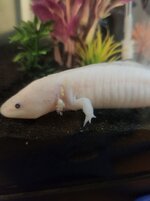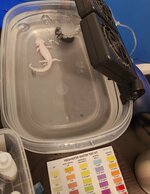blakec1211
New member
- Joined
- Aug 29, 2022
- Messages
- 28
- Reaction score
- 3
- Points
- 3
- Location
- FL
- Country
- United States
- Display Name
- blakec1211
I bought an pink leucitic axolotl about 2 weeks ago and early on i noticed my axolotl was pale so i got the water tested and turns out it had to much ammonia, water was tested before hand but water conditioner didn't get rid of the ammonia, anyways after about 2 days of being in the water, he turned pale i put him in the fridge then added API fresh start to the tank and got it tested. The water is now good ( pH-7.6, Ammonia-0ppm Nitrites-0ppm Nitrates-about 4 to 5 Temp: 64F). The axolotl remained in the fridge for about a week and then returned him to his tank (20 gallons). about 2 days ago i started doing tea baths 2x times a day and tried feeding him while he was in it. (wouldn't eat in tank either), but he is yet to eat, i have tried bloodworms nightcrawlers, and red wigglers. He doesn't seem to even notice the food or care about it even waving Infront of him he wont react. His gills have been falling off for the past few days and I think they are starting to regrow. His tail is also peeling, I'm not sure if its his slime coat or fungus but he is doing tea baths anyways so i dont think i need to do anything differently. I'm just wondering if its normal for them to peel when recovering from ammonia burn and to not eat. I'm just worried because he looks worse then while he was being fridged currently.
Currently: Day before being fridged:


Currently: Day before being fridged:


